Oedipus
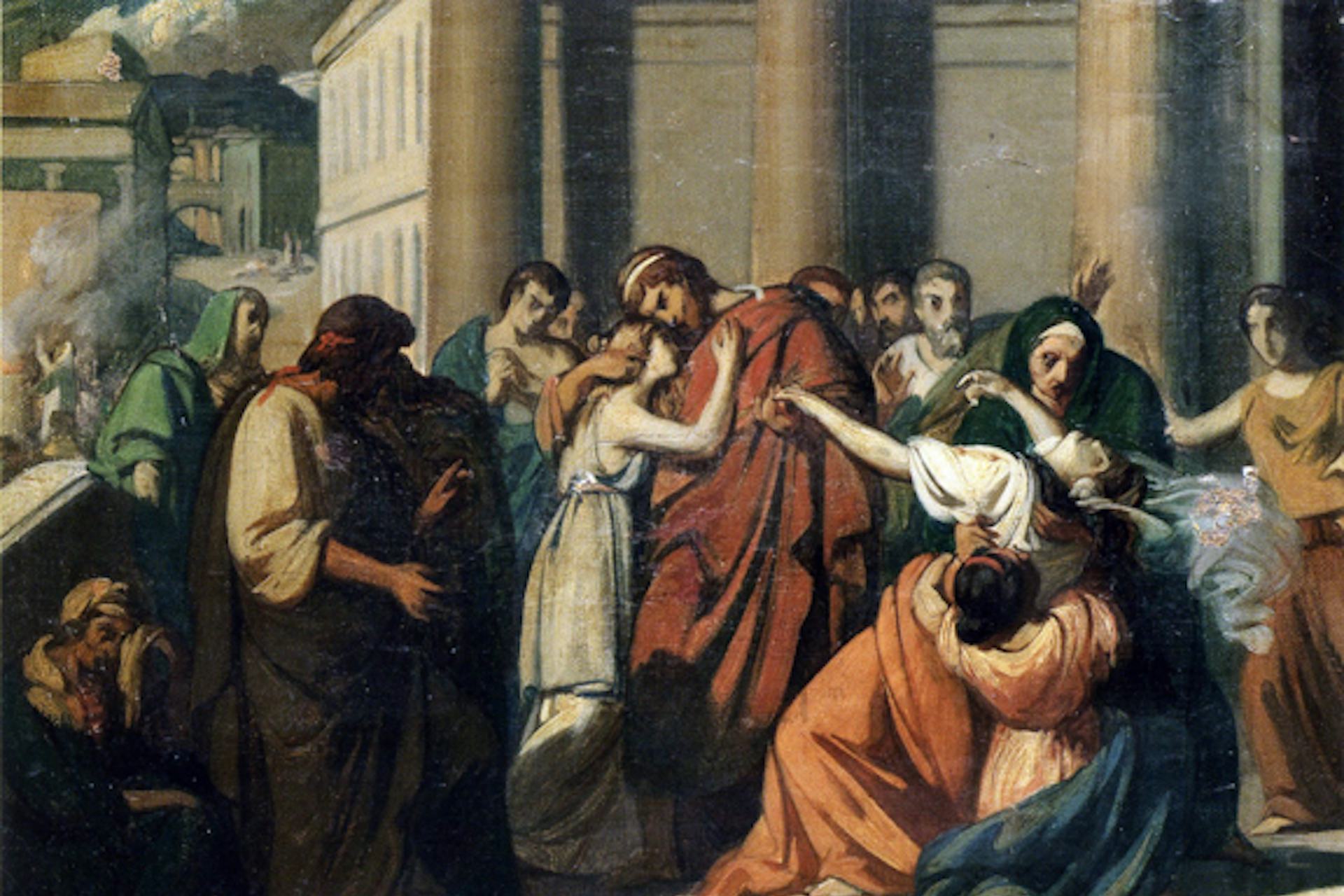
Oedipus Separating from Jocasta by Alexandre Cabanel (1843)
Wikimedia CommonsPublic DomainOverview
Oedipus, son of Laius and Jocasta, was a Greek hero and king of Thebes, celebrated for defeating the fearsome Sphinx. He suffered a tragic downfall, however, when he discovered that he had unknowingly killed his father and married his mother.
Oedipus was abandoned in the wilderness soon after his birth when his father learned of a prophecy that he would die at the hands of his son. But the child was found by a herdsman and raised by the Corinthian king Polybus.
When Oedipus heard that he was destined to kill his father and marry his mother, he left home in an effort to avoid his fate. Unfortunately, this led him to inadvertently fulfill the prophecy: he killed an old man that he met on his travels (not recognizing him as his father Laius) and later married Jocasta (not knowing she was his mother) after defeating the Sphinx.
When Oedipus found out what he had done, he blinded himself and went into exile. Because of this sharp reversal in fortune, Oedipus is often remembered as the great “tragic hero” of Greek mythology.
Key Facts
Who were Oedipus’ parents?
Oedipus was the son of Laius, the king of Thebes, and his wife Jocasta (called Epicasta in some sources). Laius had learned from an oracle that he was destined to be killed by his son, so he pierced Oedipus’ ankles with a pin and left him in the wilderness to die when he was just a baby.
Oedipus was found by a passing herdsman and raised by Polybus, the childless king of Corinth. Upon reaching adulthood, Oedipus heard the prophecy that he would kill his father and marry his mother. Thinking that Polybus and his wife were his parents, Oedipus left home to avoid this destiny and wound up in Thebes—where he ironically fulfilled the prophecy by killing Laius and marrying Jocasta, not realizing they were his true parents.

Oedipus Separating from Jocasta by Alexandre Cabanel (1843)
Wikimedia CommonsPublic DomainWhy did Oedipus blind himself?
In the standard version of his myth, Oedipus blinded himself after discovering that he had killed his father Laius and married his mother Jocasta. He did this to punish himself for his unnatural crimes.
In a lesser-known tradition, however, Oedipus did not blind himself at all. Instead, he was blinded by Laius’ attendants, who pinned him down and tore out his eyes after he killed their master.
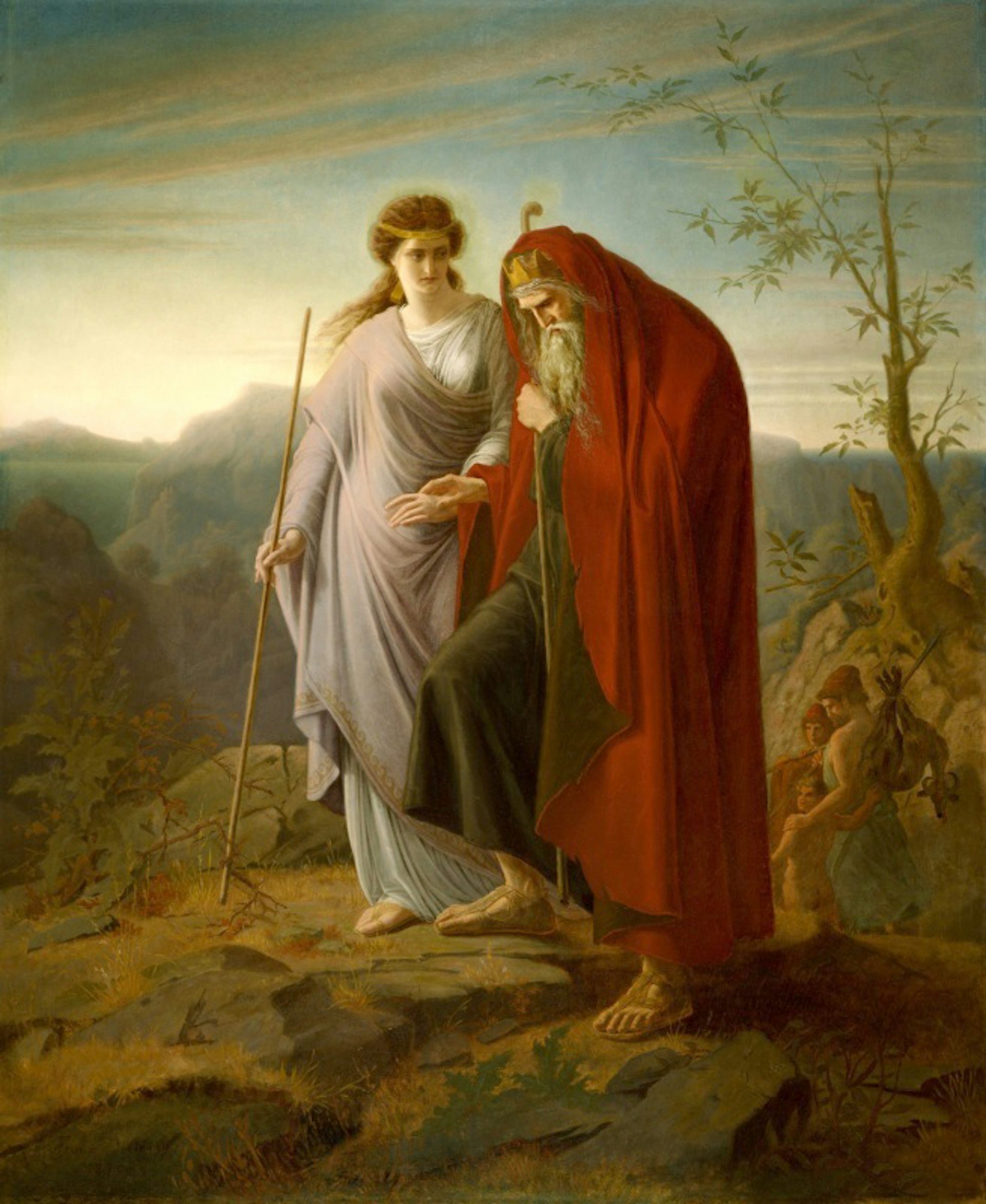
Oedipus and Antigone by Franz Dietrich (19th century)
Crocker Art Museum, SacramentoPublic DomainHow did Oedipus die?
Little is known of Oedipus’ death. After discovering his true identity, he blinded himself and went into exile, guided and cared for by his dutiful daughter Antigone. Sophocles’ tragedy Oedipus in Colonus tells of how Oedipus, by now an old man, eventually came to the Attic town of Colonus to die.
After his death, the Athenian king Theseus gave Oedipus a fine funeral and tomb at Colonus. The site where he died was thought to be sacred.
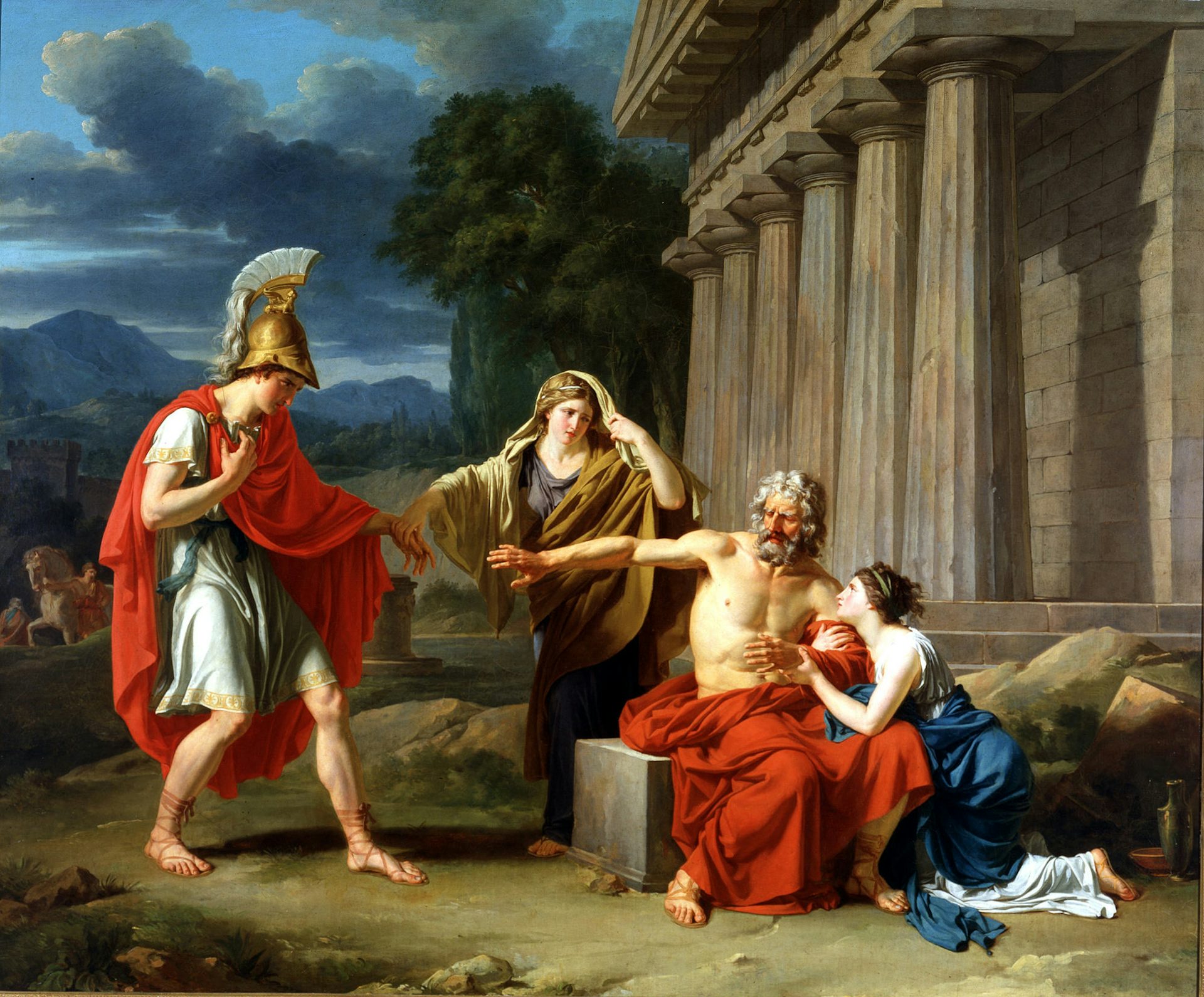
Oedipus at Colonus by Jean-Antoine-Théodore Giroust (1788)
Dallas Museum of Art (Texas)Public DomainOedipus and the Sphinx
Oedipus’ most glorious moment was his destruction of the Sphinx—a fearsome creature who was part lion, part eagle, and part woman. She occupied a cliff overlooking the road to Thebes and would kill anyone who failed to answer her riddle.
When Oedipus met the Sphinx, she posed her usual riddle to him (“What is that which has one voice and yet becomes four-footed and two-footed and three-footed?”). Oedipus answered correctly (“man”), and the Sphinx leapt to her death. The Thebans, grateful to Oedipus for ridding them of the monster, made him their king and married him to their widowed queen Jocasta.

Oedipus and the Sphinx by Jean-Auguste-Dominique Ingres (1864)
The Walters Art MuseumCC0Etymology
The name “Oedipus” is derived from the Greek verb oideō, meaning “to swell,” and the noun pous, meaning “foot.” Oedipus’ name thus translates to “he who has a swollen foot.” This etymology is reflected in the myth that Oedipus’ ankles were pierced when he was abandoned as a baby.[1]
An alternative etymology derives the name from the verb oida, “to know” (rather than oideō, “to swell”), so that Oedipus’ name means “he who knows feet.” This is also related to his mythology, for the famous “riddle of the Sphinx,” which Oedipus solved, was about feet.
Pronunciation
English
Greek
Oedipus Οἰδίπους Phonetic
IPA
[ED-uh-puhs, EE-duh-] /ˈɛd ə pəs, ˈi də-/
Alternate Names
There are a handful of variants of Oedipus’ name, including Oedipos, Oedipodos, and Oedipoun.
Family
Oedipus’ father was Laius, a king of Thebes. His mother was usually named as Jocasta,[2] though ancient sources did not all agree on this name: Homer, for example, called Oedipus’ mother Epicasta.[3] In some traditions, Laius fathered several other children, including the Sphinx, with various concubines.[4]
After being raised in Corinth by Polybus and his wife (whose name was either Merope,[5] Periboea,[6] or Medusa[7]), Oedipus found his way back to Thebes and unknowingly married his own mother.
Family Tree
Mythology
Origins
Before Oedipus was born, the Theban king Laius had been warned by an oracle that if he ever had a son, that son would someday kill him. Despite the prophecy, Laius slept with his wife Jocasta (sometimes called Epicasta) one night while he was drunk. Soon after, Oedipus was born. Hoping to escape his preordained doom, Laius pierced the baby’s ankles with pins and left him to die in the mountains.
But a passing herdsman found the baby and took him to Polybus, the king of Corinth (about 85 miles southeast of Thebes). Polybus brought the child up as his own, naming him “Oedipus” (“he who has a swollen foot”) because the pins Laius had placed in the baby’s ankles left his feet permanently swollen.[11]
Delphi and the Old King
Once Oedipus was an adult, he learned from the oracle at Delphi that he would kill his father and commit incest with his mother. He therefore vowed never to return to Corinth, believing that that was where his parents lived.
As he was leaving Delphi, Oedipus met an old man at a crossroads (often associated with a real crossroads in ancient Greece called the “Triple Way” or the “Cleft Way”). The two quarreled, the argument grew heated, and Oedipus ended up killing the old man. What he did not know was that the man was none other than Laius, the king of Thebes and his real father.[12]
The Sphinx
Continuing his travels, Oedipus crossed paths with the Sphinx, a creature usually represented with the head of a woman, the body of a lion, and bird’s wings.[13] Ever since Laius’ death (by Oedipus), the Sphinx had been terrorizing Thebes by sitting on a cliff outside the city and putting a riddle to any Theban who passed by. If the Theban could not solve the riddle, she killed him on the spot.

Red-figure Kylix from Vulci showing Oedipus and the Sphinx. Attributed to the Oedipus Painter (ca. 470 BCE). Vatican Museums, Vatican.
Carole RaddatoCC BY-SA 2.0When the Sphinx saw Oedipus, she presented her riddle as always, usually quoted as: “What is that which has one voice and yet becomes four-footed and two-footed and three-footed?”[14]
The answer, Oedipus realized, was “a human being”: humans crawl on four legs as babies, walk on two legs as adults, and become “three-footed” in old age (when they use a cane to walk). As soon as Oedipus solved the riddle, the Sphinx killed herself by leaping from her cliff.
The Thebans were overjoyed to finally be free of the Sphinx. To reward Oedipus, they made him their king and gave him as his bride Jocasta (or Epicasta), their queen and the widow of the late king Laius.[15]
Though this was the most common version of the Sphinx myth, it was not the only one. In some traditions, the Sphinx was a bandit who was defeated by Oedipus and his Corinthian army,[16] while in others she was actually a bastard daughter of Laius who murdered all who claimed to be Laius’ sons until Oedipus outsmarted her.[17]
Downfall
Eventually, however, Oedipus’ good fortune took a dark turn. He discovered that the old man he had killed was his true father, Laius, and that the queen he had married was his mother. He had thus fulfilled the prophecy, despite his best efforts to avoid it.
In the most familiar version, first attested in Sophocles’ tragedy Oedipus Tyrannus, Oedipus’ downfall all began with a plague. After consulting an oracle, Oedipus discovered that Thebes was under blood-guilt for the murder of the old king Laius: the plague would end only after the killer had been exiled from the city.
Oedipus immediately began investigating the murder, only to discover not only that he was the one who had committed the deed, but that Laius was in fact his real father—and that Laius’ widow, to whom he was married, was his mother!
Oedipus and Jocasta were both horrified by this discovery. In the common tradition, Jocasta killed herself, while Oedipus blinded himself.[18]
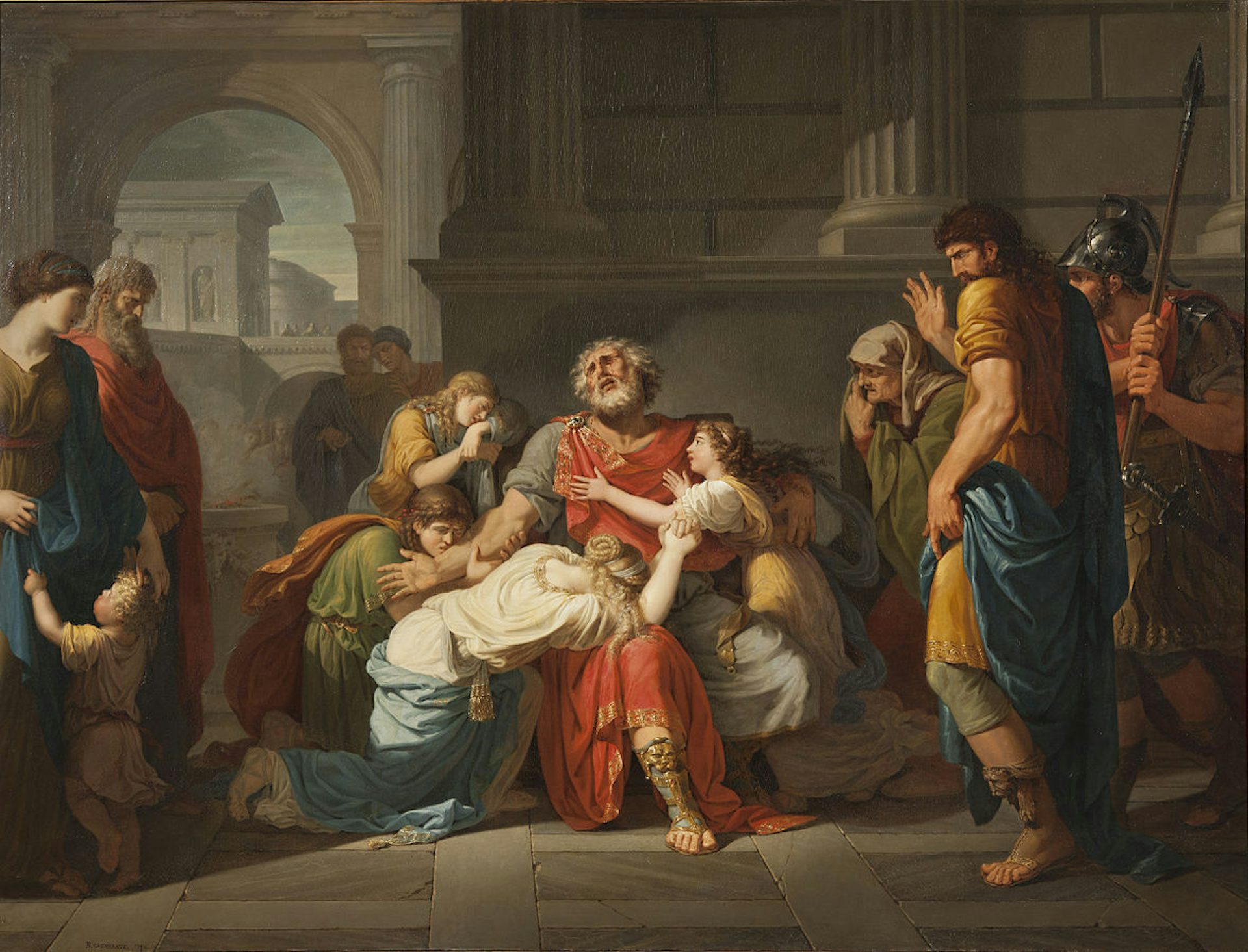
The Blind Oedipus Commending his Children to the Gods by Bénigne Gagneraux (1784). Nationalmuseum, Stockholm, Sweden.
Wikimedia CommonsPublic DomainHowever, not all sources agreed about the fates of Oedipus and Jocasta. According to some traditions, Jocasta did not kill herself until much later, after the deaths of her sons Eteocles and Polyneices.[19] Possibly even more surprising are the traditions in which Oedipus did not blind himself but rather was blinded much earlier—either by Laius’ servants[20] or even by his foster father, Polybus.[21]
The Fate of Oedipus
What happened to Oedipus after he discovered his crimes was much contested in antiquity.
In some traditions, Oedipus was sent into exile by either his brother-in-law (and uncle) Creon or by his own sons, Eteocles and Polyneices. Only his devoted daughter Antigone accompanied him, helping him in his blindness and his old age.[22] In other traditions, Eteocles and Polyneices imprisoned Oedipus in Thebes to hide his disgrace from the world.[23]
According to Homer, however, nothing changed at all: Oedipus continued to rule Thebes until he eventually fell in battle.[24]
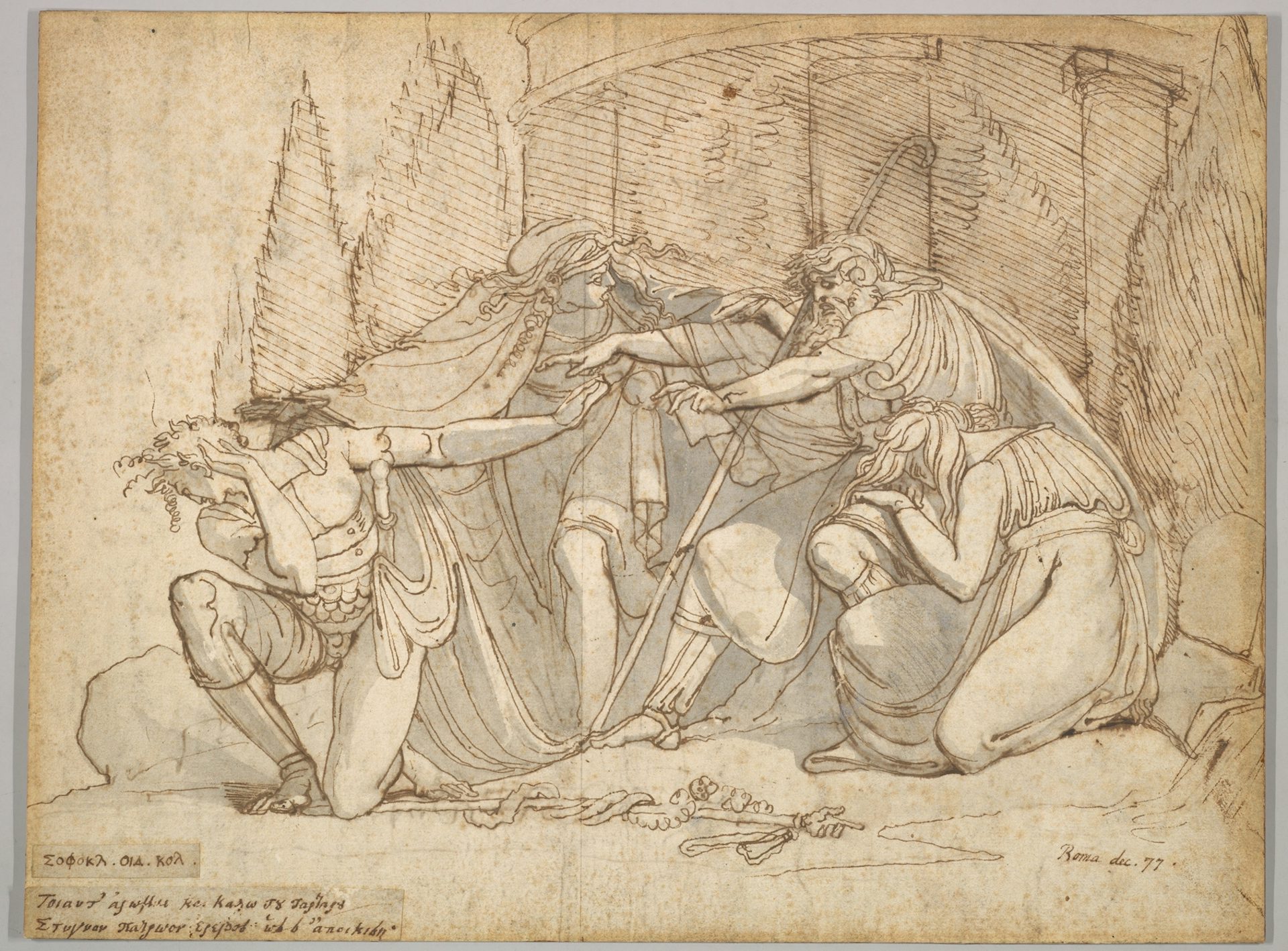
Oedipus at Colonus, Cursing his Son Polynices by Henry Fuseli (1777).
Metropolitan Museum of ArtPublic DomainIn many traditions, Oedipus also cursed his sons, either because they disrespected him,[25] because they did not help him when he was exiled from his city,[26] or because they imprisoned him in Thebes.[27] In time, the curse was fulfilled: Eteocles and Polyneices quarreled over which one of them should rule Thebes and ultimately killed each other in battle.
According to a popular tradition, Oedipus eventually came to the Attic town of Colonus, not far from Athens. An old and broken man, he finally found some peace: he was honored by the Athenian king Theseus and given a funeral after he died. The spot at Colonus where he died was considered sacred.[28]
Worship
There were tombs and hero cults of Oedipus in the region of ancient Attica, including in Colonus and Athens itself.[29] Oedipus was also worshipped in other parts of the Greek world, including Sparta, the island of Thera,[30] and the Boeotian town of Eteonus.[31]
Pop Culture
In modern pop culture, Oedipus is perhaps best remembered through Sigmund Freud’s concept of the “Oedipus complex.” Freud used the myth of Oedipus (specifically, Sophocles’ version) to illustrate the male’s unconscious desire to become the sole object of his mother’s love by killing his father. The Oedipus complex remains a famous and central tenet of psychoanalytic theory.
The myth of Oedipus has also been adapted for the arts. He was a strangely popular figure in the 1960s, a decade that saw the release of at least two films based on the Oedipus myth: Oedipus Rex (1967), from Italian director Pier Paolo Pasolini, and Oedipus the King (1968), starring Christopher Plummer in the titular role. Rota Otimi’s novel The Gods Are Not to Blame (1971) is an adaptation of the myth set in a Yoruba kingdom (originally published as a play in 1968).